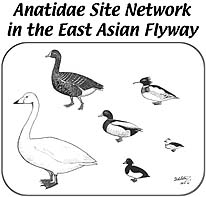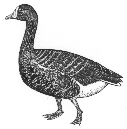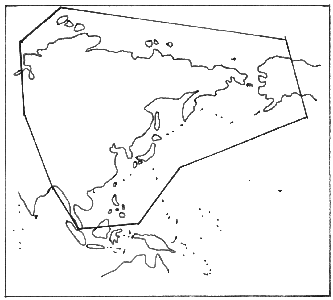
Anatidae Site Network in the East Asian Flyway
Introduction to the Site Network
[ in Japanese ] [ Back ]
[ What's New ] |
[ Site Network ] |
[ Action Plan ] |
[ Links ] |
[ Atlas ] |
[ Sitemap ] |
[ Japanese pages ] |
[ Network Sites ] |
[ Activities ] |
[ Introduction ] |
[ Contacts ] |
|
|
Anatidae Site Network in the East Asian Flyway Introduction to the Site Network[ in Japanese ] [ Back ] |
|
Anatidae Anatidae is the name of the family consisting of ducks, geese and swans. Migration Many populations of the Anatidae species are migratory. The typical migrations of Anatidae are of populations breeding in the Arctic or northern temperate regions and wintering in temperate and tropical zones. During their migration, they regularly cross international borders of several countries and territories. Many tropical species are sedentary while others mainly have seasonal movements related to the occurrence of rains and the temporary flooding of wetlands. Almost all Anatidae species are temporarily flightless during the moult of their flight-feathers after breeding, and many species make "moult migration" to the safe moulting grounds. Thus, the conservation of these populations and their habitats requires cooperation at regional and international levels. [ Top ] |
Contents
Site Network
 The Site Network is a cooperative international programme with nominating key sites of international importance to the Anatidae populations (ducks, geese and swans) in the East Asian Flyway.
The Site Network is a cooperative international programme with nominating key sites of international importance to the Anatidae populations (ducks, geese and swans) in the East Asian Flyway.
 The goal of the Site Network is to ensure the long-term conservation of migratory Anatidae populations through recognition and appropriate management of a network of sites of international importance. It is a network of both sites and people and assists conservation activities of site owners, managers, local people and participating organisations.
The goal of the Site Network is to ensure the long-term conservation of migratory Anatidae populations through recognition and appropriate management of a network of sites of international importance. It is a network of both sites and people and assists conservation activities of site owners, managers, local people and participating organisations.

Geographic range of the East Asian Flyway of Anatidae
The Site Network is coordinated by Wetlands International under the Asia-Pacific Waterbird Conservation Strategy (Wetlands International 1996, 2001). The Anatidae Working Group has been established to oversee the implementation of Anatidae Site Network by the Migratory Waterbird Conservation Committee. The Anatidae Flyway Officer has been employed by Wetlands International - Japan for assisting activities of the Site Network.
The Site Network was launched on 14 May 1999 during the 7th Meeting of the Contracting Parties of Ramsar Convention (San José, Costa Rica, 10-18 May 1999).
This website is an official homepage of the Site Network edited by the Anatidae Flyway Officer for publicizing the activities of the Site Network to the world and also for the assistance to the activities in the Network Sites with providing useful information on the management of Anatidae populations and their habitats.
[ Top ]
|
Significance of the Site Network The Convention on Wetlands (Ramsar, Iran, 1971) has encouraged countries in the region to promote Asia-Pacific Migratory Waterbird Conservation Strategy and to join the Site Networks (Rec. 6.4 and Rec. 7.3) since its 6th Meeting of the Contracting Parties in 1996. It is because:
And the Convention incorporated the significance of the Site Network into its Guidelines for international cooperation under the Ramsar Convention adopted as annex to RES. VII.19 in 1999, when our Anatidae Site Network was launched. [ Top ] |
Activities of the Site Network
The Site Network encourages site management bodies and/or relevant organisations to the management of the site to promote appropriate management of the site through development of a site management plan and other conservation measures and to promote the local recognition of the importance of the site for the conservation of Anatidae populations through the awareness and educational programmes. The Site Network provides training opportunities to assist them for these activities. Participation in exchange of information, knowledge and people through the Site Network will help these activities as well.
The Flyway Officer assists the activities in Network Sites through facilitating communication and information exchange and providing advices, with building a network of various organisations, governmental and non-governmental, and personals such as scientists and experts.
The Site Network provides information on their activities through newsletters and on the internet to the wide audience in the world, and also promotes the nomination of other sites of international importance.
[ Top ]
Key sites
Identified as a site of international importance to Anatidae, eligible to join the Site Network if:
[ Top ]
|
Application forms
|
Nomination of a site to the Site Network
Site management bodies prepare the nomination document with providing information of the importance of the site, and the national government proposes for the nomination to Wetlands International.
[ Top ]
Participation in the activities
The Site Network is an international co-operative programme that bring together everyone who is interested in the conservation of Anatidae populations and wise use of their habitats. Participants may take part in the activities planned under the initiative and conducted at the Network Sites. For individual participants, refer to another page of "How to participate in the activities".
Government organisations and management authorities of the sites are encouraged to invite participation of local people and non-government organisations in the activities in their site(s) for conservation, management, awareness and education, and others.
Non-government organisations relevant to the Anatidae species and their wetland habitats can play a crucial role for the enhancement of the conservation of Network Sites and other sites of international importance with assisting research and monitoring of the sites and Anatidae populations, communication and awareness on their importance, assisting training opportunities for the sites, and so on.
[ Top ]
The presentation of materials in this website and the geographical designations employed do not imply the expression of any opinion whatsoever on the part of Wetlands International concerning the legal status of any country, territory or area, or concerning the delimitation of its frontiers or boundaries.
[ Top ] [ in Japanese ] [ Back ]
[ Network Sites ] |
[ Activities ] |
[ Introduction ] |
[ Contacts ] |
[ What's New ] |
[ Site Network ] |
[ Action Plan ] |
[ Links ] |
[ Atlas ] |
[ Sitemap ] |
[ Japanese pages ] |